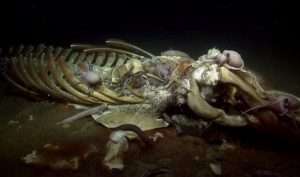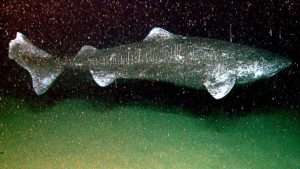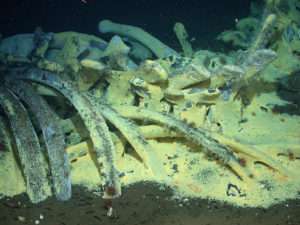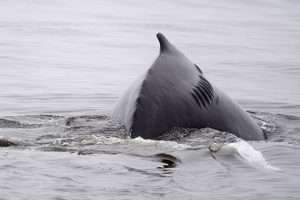
We often think of ecosystems as large areas of land and water that may cover many square miles. The truth is that they come in many sizes, and may shift, change, and even disappear depending on factors like climate, natural disasters, and so forth. But there are some phenomena that are essentially micro-ecosystems that only take up a very small space in the grand scheme of things. One of the neatest examples of this is a whale fall.
Whales include the largest animals that have ever lived; a blue whale (Balaenoptera musculus) may reach almost 100 feet in length and weigh over 200 tons. When a whale dies close to shore it may end up washed onto the beach; the waves may carry it back into the water as the tide returns, or humans may have to resort to drastic measures to remove the giant carcass (up to, and including, blowing it up with half a ton of explosives.)
However, most whale carcasses ended up sinking to the ocean floor. When it lands at a depth of 3,300 feet or greater, it enters into parts of the ocean completely devoid of light and harboring unusual life forms not found elsewhere. These areas are known as the bathypelagic and abyssopelagic zones; rarely, a whale might even fall into a trench so deep that it is part of the deepest zone of all, the hadopelagic. However, the deeper you go, the fewer living beings can survive in these harsh conditions; fish, for example, probably cannot survive beyond about 28,000 feet deep at the extreme. Thus whale fall ecosystems are primarily known from relatively shallower areas of the benthic and abyssal zones.
Whale Fall Stages
When a whale carcass settles on the ocean floor, it is an incredible bounty to the fish, crustaceans, molluscs, and other living beings there. Different groups of beings feast on the meat and bones of the whale, and the process of decomposition may take many years to complete. There are three main stages of a whale fall ecosystem:
 The mobile scavenger stage is when larger animals like hagfish (Myxini spp.) and sleeper sharks (Somniosidae spp.) start eating the flesh of the dead whale. These scavengers may reduce the carcass by over 100lb of meat a day, and this stage can last from a few months to a year and a half, depending on the size of the whale and the number of scavengers.
The mobile scavenger stage is when larger animals like hagfish (Myxini spp.) and sleeper sharks (Somniosidae spp.) start eating the flesh of the dead whale. These scavengers may reduce the carcass by over 100lb of meat a day, and this stage can last from a few months to a year and a half, depending on the size of the whale and the number of scavengers.- Next comes the enrichment-opportunistic stage. The scavengers usually do not eat every single fragment of flesh, and so other animals move into consume the smaller bits left behind. Certain molluscs and worms can also eat the bone itself. Some species taking advantage of this stage may even form colonies on or around the whale carcass, and while there aren’t very many species adapted to this niche, they often show up in large numbers. They may stay there anywhere from several months to over four years.
- The third stage is the sulfophilic stage, and this is where things get really unusual. The whale carcass becomes a fully-fledged ecosystem powered by chemosynthetic bacteria. These bacteria are able to extract and process fats in the whale bones. Rather than breathing straight oxygen from the water, they instead inhale sulfate to gain the oxygen they need, and exhale hydrogen sulfide. Other species of bacteria can then capture the hydrogen sulfide, combine it with oxygen, and create a source of energy. It is these sulfide-consuming bacteria that are the backbone of the longest stage of the whale fall ecosystem; some animals have symbiotic relationships with them, while others simply eat them. Because of the immense amount of fats in a whale’s bones, it may take the better part of a century for the bacteria to completely deplete this important source of nutrients.
 A fourth stage has been posited by scientists, the reef stage. Here the bones become structures for stationary animals and other life forms to form long-term colonies. The bones may last for thousands of years; one example in this paper was thought to have been on the ocean floor for 10,000 years.
A fourth stage has been posited by scientists, the reef stage. Here the bones become structures for stationary animals and other life forms to form long-term colonies. The bones may last for thousands of years; one example in this paper was thought to have been on the ocean floor for 10,000 years.
Whale falls, then, create numerous opportunities in a deep ocean habitat where resources can be quite scarce. Because two whale falls may be only a few miles from each other, species may be able to migrate from one to another; even stationary species may have migratory larval stages. The complexity of the whale fall ecosystem is such that it can support multiple trophic levels, or layers in the food web, which in turn provide many niches for organisms to inhabit. Many of the living beings found in this ecosystem are endemic to it, meaning they are found nowhere else in the world.
It’s estimated that 69,000 whale carcasses fall to the ocean floor every year, with about 690,000 in some state of decay at any given time. Before commercial whaling drove some whales close to extinction, the number of active whale falls would have been several times greater. (It also makes one wonder about similar ecosystems long before whales evolved, for example “plesiosaur falls”.)
Preserving Whale Falls for Generations to Come

Today, while numbers of some whales have rebounded substantially with the decreased in commercial whaling, whales are far from being completely safe. The North Atlantic right whale’s (Eubalaena glacialis) numbers hover have dropped to 350 in their western population, and maybe a few dozen in the eastern. Other whales may follow suit as climate change, habitat loss, pollution, and other pressures destroy their food sources, like the spring chinook salmon (Oncorhynchus tshawytscha) that northwest resident orcas (Orcinus orca) rely on for food. A few countries such as Japan and Norway still allow commercial whaling; often prohibited species are caught along with legal, and countries may report smaller numbers than what were actually hunted. And all whales are seeing losses from being struck by commercial ships and drowning after being entangled in fishing gear.
If we lose whales, we lose all the species that are reliant on their remains to create these oases of life deep in the oceans. The Pacific Whale Foundation lists forty things you can do to help save whales, but among the most important things we can do is to pressure corporations and governments to reduce ship strikes and fishing gear entanglements through regulations and better technology. “Save the whales!” isn’t just a catch phrase from 20th century environmentalists; it’s an ongoing goal that will have effects for countless species many of us may never lay eyes on.
